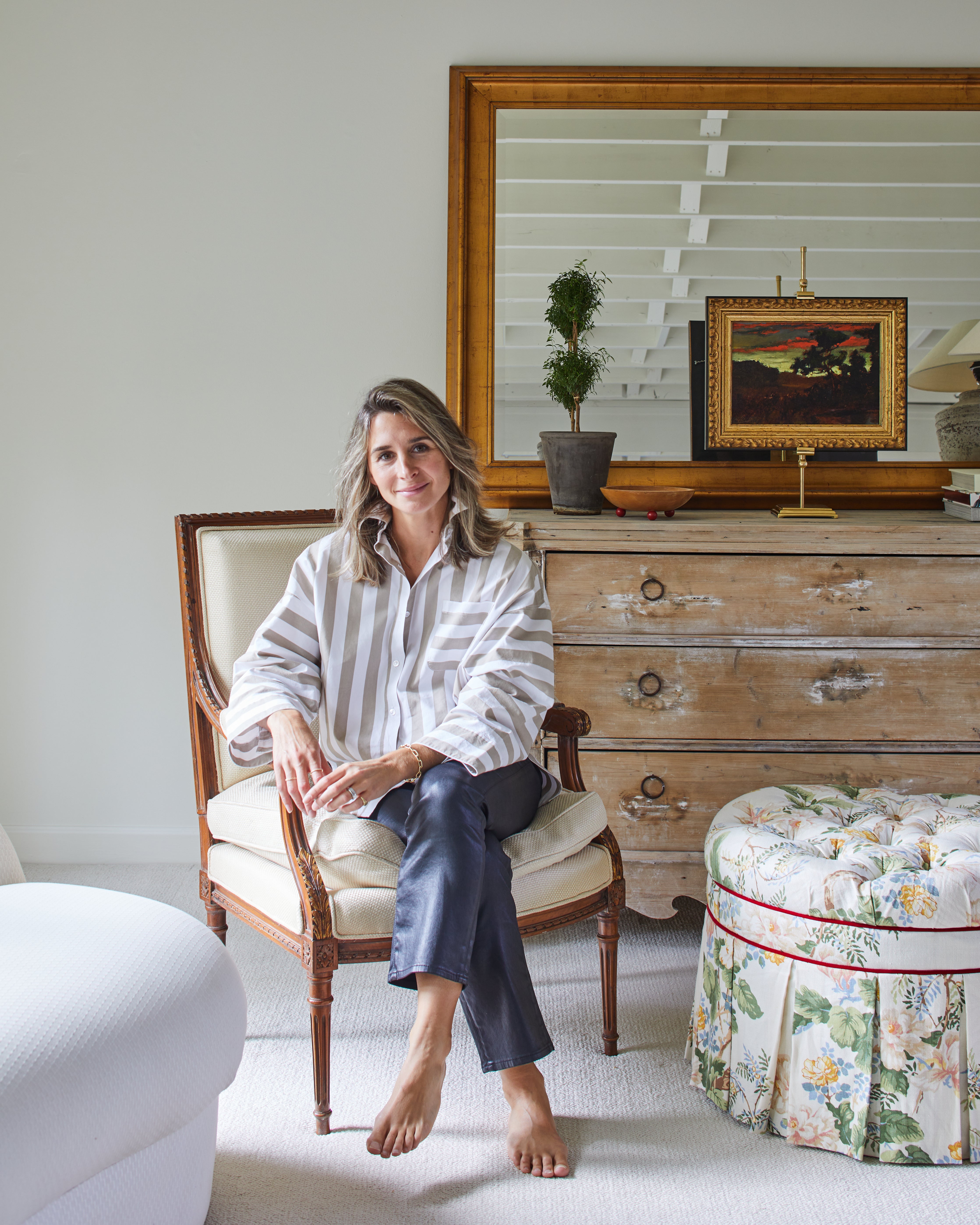The 50 States Project is a series of candid conversations with interior designers across the country about how they’ve built their businesses. This week, Greenville, South Carolina–based Whitney McGregor tells us what she learned from an early client “disaster,” why she misses design blogging, and why she has mixed feelings about becoming close with her clients.
Did you always know you wanted to be a designer?
I did. My great-grandmother was a sculptor, and I had a great uncle who was a fashion designer. Growing up, I remember our furniture being very out there. My dad was more into the building side, and we grew up in a cool house—a super unique, sprawling ranch that my parents renovated and added on to—until I was 6 and my parents divorced. I remember my mom picking me up from school after work and being like, “We’ve got 20 minutes to get to the Lazarus home outlet before they close.” We’d zoom downtown to this warehouse of furniture because she was always on the hunt for something. She was really big into the arts, and always encouraged us—well, really, at the time, forced us—to go to a lot of art museums and performances and shows. It was sort of like I was being molded.
In high school, I wanted to do my room. The walls were grasscloth, but we painted them periwinkle and the wood floors white. It was just something that I did—I never thought that’s something you could do for a job. Then my mom started getting Domino magazine, and I remember thinking, “Oh, my God, this is everything. I’ve never seen anything like it before.”
Did you go to design school?
No. My parents were like, “You have to go to business school and get a real degree,” which was the worst advice anyone ever gave me. But I did that. My senior year [of college], I was like, “OK, I did this thing. So my gift to myself is I’m going to go to France and study fine art.” And it pretty much changed everything. At that point, I had no self-awareness. I needed somebody to shake me and be like, “You’ve literally been decorating rooms for your whole life. You need to do this.”
Or, “Hey, you have a talent. This isn’t something everybody can do.”
Right. But I was surrounded by a family of creative, artistic people, so it wasn’t that abnormal for me. I was surrounded by a bunch of frustrated should-have-been interior designers. And then I went to France, and even the waiters there were passionate. Everybody loved what they did. I thought, “I can’t go back to the States and sit in a cubicle, I just can’t.” And that’s when I got really serious about design.
I had started dabbling with DIY decor and blogging about it, but I still really had no intention at that point. Then I got married. The floral designer and wedding planner and the photographer came to the house, and everyone was like, “Who did your house? Tell me about your house.” And then they were like, “Can you help me with my house?” And it just sort of went from there. That was almost 12 years ago, and I’m still trying to figure it out. I never worked for somebody, which is a huge regret. I envy people who worked for big designers because I had to figure it all out on my own.
When and how did you transition from design as a hobby to a career?
My wedding photographer and I were friends, and for a while I would make suggestions and we would go to antiques stores together. At the same time, she was really savvy with business and was kind of guiding me, saying, “You need to charge for this.”
I also had a few out-of-town projects, including a woman from Charleston. I don’t even know how she found me, maybe the blogosphere, but it was a disaster. I went to her house and did all these measurements. I think I had watched too many HGTV shows and thought that I was going to just go get all this stuff and install it one day as a surprise. And she hated it. I ended up with all of this stuff that I really couldn’t afford. It was horrible. I was doing $50-an-hour consultations with a really specific scheme and then coming and installing things. And my mom sewed, so she make sew a lot of my stuff—the curtains, pillows and cushions. I was also very deep in having babies at that point. I remember taking my son in a baby carrier to install this Charleston project for the full day. It was all just figuring it out.
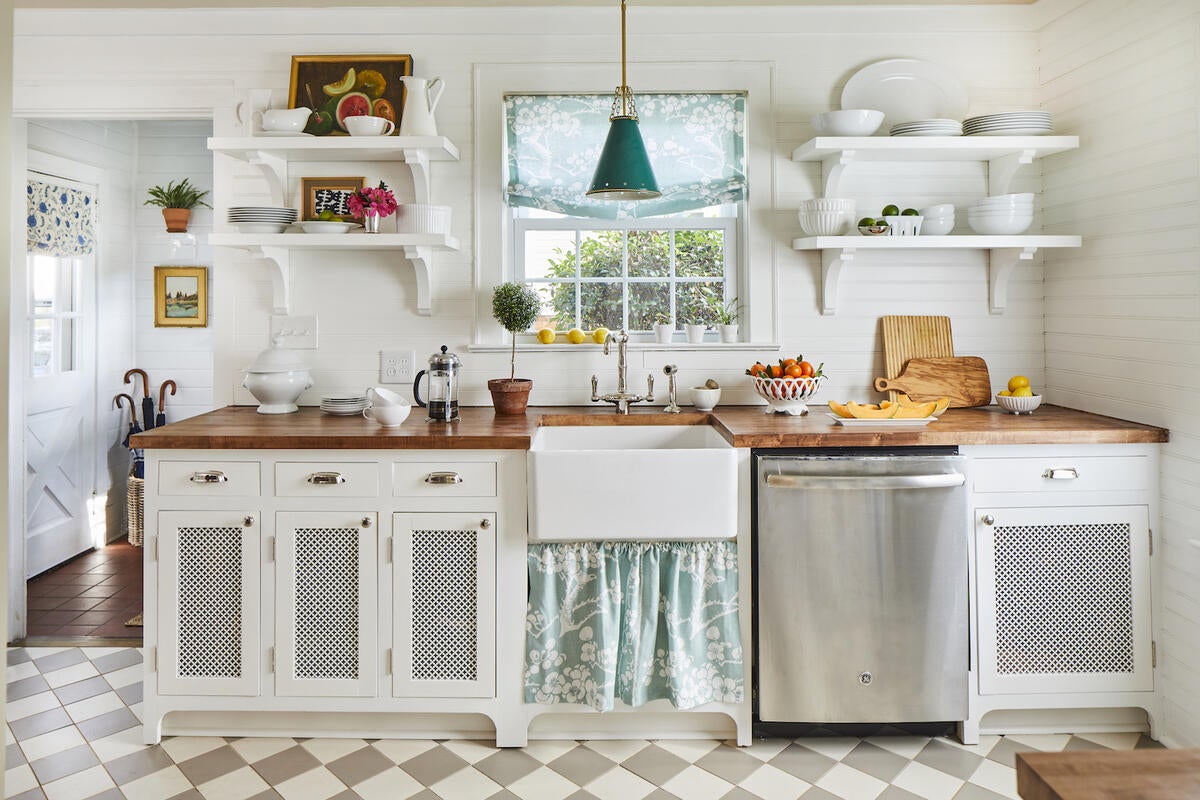
But that’s what it takes, right?
Right—a lot of hard lessons. And definitely a lot of one foot in, one foot out. I would go hard and have like three weeks where I hardly slept and was just surviving. Then we moved to Greenville when my husband was transferred for work. Everything kind of stopped while we figured that out, and I finally came to terms with the fact that I wasn’t cut out to be a stay-at-home mom. That’s when I started working at a local home store in Greenville.
What made you want to get out and do that?
I knew no one here, and I had to meet clients somehow. The store wasn’t anything spectacular, but it was so fun to go in. I’d work on Saturdays, and then an occasional weekday, and we would rearrange and make vignettes. I did that for almost a year and met some clients working there. At the beginning I did a referral system—if you referred somebody to me, you got an hour or two of free time. These women in Greenville will chew you up and spit you out, but they’re very frugal, so I was getting referred like crazy. It wasn’t for anything great—a lot of just pillow fluffing and going into your house and moving mountains in two hours—but that’s my jam. I loved going into people’s houses and saying, “Let’s move this here, let’s try this here.” And people are so blown away when you do that.
How did you grow your business from there?
At the beginning, the biggest opportunities I got were from moms. I was kind of a younger mom, but a lot of the people who my kids went to school with were a little bit older and had a different financial situation.
Was there a moment where you felt like things were really taking off?
I had studied abroad in France with [Richmond, Virginia–based designer] Elly Poston [who was then an editor at Southern Living], who had worked for Ashley Whittaker and Meg Braff. She reached out a couple times and was like, “Hey, when are you ready to send us to scout your house in Greenville?” And I was like, “Oh, my God, I’m so far from ready.” The third time she asked, in January of 2018, I was like, “She’s not going to ask again,” so I said yes but asked for six months. I knew I was going to need every single day of that time to finish this house so that it was worthy of being photographed. We begged, borrowed and stole to get that house ready—I felt like a lobbyist or something. We somehow managed to pull together a kitchen renovation. All of the stars aligned. That was my first Southern Living feature, which was in the best of the South issue in April of 2019. That felt like: “OK, I made it through that door, on to the next one.”
Did that feature change something for your business?
It changed my level of confidence, but it came out and it was crickets. I didn’t get a single inquiry. I would get a phone call from a lady in Birmingham, and she’d want to know my paint color in the dining room or where the curtains were from, but it didn’t really do anything tangible except show me that, “Oh, wow, OK, I’m published now. This means it’s getting serious.” Around the time that it came out, Olivia Brock in Charleston referred a project to me—somebody had reached out to her because she had just done [South Carolina-based blogger] Julia Berolzheimer’s house, but she was full, so she said, “Call Whitney McGregor.” It was just so generous. The client had never heard of me. It’s still one of my biggest projects that I’ve ever had. And it gave me good street cred. It was all a whirlwind after that.
Were you still blogging at that point?
Yes. I didn’t blog consistently, but I did blog for years. I liken it to writing a dissertation—I would deep dive and then reflect. From the very beginning, I would dissect a room or a designer who I loved and be like, “OK, what’s the formula here? What are they doing again and again, and why is it working?” I was getting an education.
That makes me miss blogs.
I know. And I love journaling, which is something I miss about blogging—sitting down and just reflecting and writing, because I think it’s so healthy.

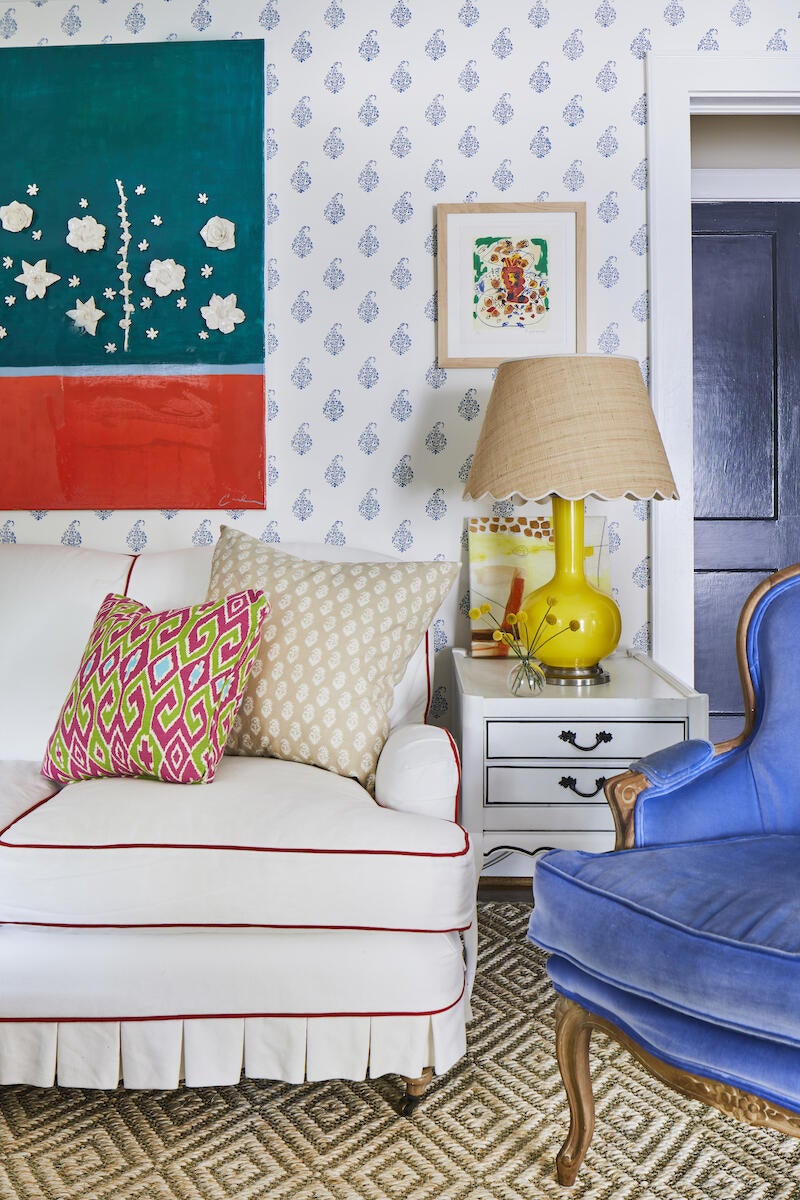
Fast-forwarding to today, what does your business look like now?
When I got serious, l was like, “I’m only taking projects with a $100,000 minimum budget.” And I was sort of rigid about that for a while—last year, I only had projects that met my minimum. Then I got very sick, so I turned some things away. But now that my business is more streamlined and I actually have an employee or two, I feel like I have more flexibility to take on things that don’t fit in [those parameters]. It’s such an ebb and flow.
I also feel like I grew a little bit too quickly. In the spring of 2021, I was on the verge of having three employees, and we were taking on things that I didn’t want to do because I didn’t want to leave money on the table. And then it was like, “Whoa, this doesn’t work.” So I scaled back, but I’m still left with some of those smaller projects. And then as my social circle grows here in Greenville, I find myself taking on things that I probably wouldn’t [if the client wasn’t a friend].
Right now, I have a big project in Washington, D.C., that’s ongoing. I’ve got two in Athens, Georgia, and one in Spartanburg that’s starting to ramp up. I finished a big one in Nantucket this summer, and then I’ve got a couple of small ones here in Greenville. And then a smaller one in Fairhope, Alabama. These smaller jobs—I’ve found [that starting my career] in a very bootstrapped way, as far as brand identity goes, I’ve had a hard time getting past that.
Was it hard to pivot out of that mindset?
Yes, it is. I will get clients who are considering me, [New York–based designer] Lilse McKenna [and Dallas-based designer] Amy Berry, and then I lose to those two because they’re amazing. [Those designers] get the project with a $5 million budget, and I get the $50,000 budget for 10 rooms. My Nantucket project, for instance, was an amazing opportunity. I love these clients. They bought a $2 million house, but all the furniture we got was either from an estate sale or Facebook marketplace. We ended up spending hundreds of thousands of dollars, but we could have easily spent a million.
I also think in this world, there’s this major glass ceiling. Like, tell me a famous designer who didn’t come from a wealthy family. There isn’t one that I know of. When I listen to [design podcasts where designers share their origin stories] my husband is like, “That’s not real life. What about people who actually have to build their business from scratch? This doesn’t help you.” I’m just so used to hearing that same story in this world—stories like, “Well, David Hicks did our house, so we knew him, and I just graduated from college and went to work for him,” or your grandmother wrote a letter to Mark Hampton saying you needed a job, and the rest is history. That’s not my life. But I feel like people are more comfortable hiring within their world, which has been really hard. It’s almost like I want people to think that we have money—a lot of money. And we don’t. But in order to get those big jobs, I need people to think that I do.
This business can be so weird because everything is so expensive, the work is so time-consuming, and your home represents so much of who you are—to yourself, but also to the outside world. It’s really fraught.
It is. It’s very hard. I have some amazing projects, but I worked myself to the bone. And I’m now like, “Yeah, I made a lot of money last year. But when I look back on this project, am I really fulfilled?” It’s tough too because you can’t get the projects that you want unless you have a project that you want. I think that’s why the breakout project for a lot of designers is their own house—they either already have money or they have a wealthy spouse, so they can spend millions on their own house, it can be in Veranda, and then everyone can see what they can do and hire them to do it.
When I started to get the clients with bigger budgets, I took less of a markup so we could use nicer products because I needed people to see that I had projects where we used those things. Those kinds of growing pains are constant. When you are creative and run your own business, you get to a point when you’re like, “OK, I’ve got to shed my skin and go to the next level.” Anytime that happens, it’s a little painful. That’s sort of where I feel like I am right now.
How are you looking to evolve?
Something that I struggle with is becoming very close with my clients. It can be draining when you are empathic and you work so closely with people. I have projects where I’m very close with the client, but then I’ll also feel the brunt when we go over budget and all of a sudden, I’m grouped in with the wife and the husband’s pissed at both of us. It’s sort of like, “Well, I didn’t do this alone—you knew everything you were getting into. Nothing is a surprise.” But you can get wrapped up in clients’ marital and family dynamics.
I have clients text me, too—and it’s nothing that they’re doing wrong, it’s totally me. I’m just very caring and empathic, so I think I have to be careful. I’ve heard from other designers who I respect and admire about not doing that, and how that can be a crutch. And that a lot of times, the clients with those big projects and huge budgets don’t actually want all that. They want somebody who’s the consummate professional and very boundaried. I struggle with that, because I don’t know how to not be the way I am—and it’s also fulfilling. I love getting to know people, and I love the personal.
You mentioned that you have a team now. When did you start hiring, and what roles do your team members play?
For my first hire, I really needed an administrative person—that’s what I thought [the guy we hired] was going to be. I have ultimately tried to hire three different people for that same role. I found that they were just frustrated creatives—they’re kind of like, “Yeah, I’ll do anything. I can help you with your books.” And then all of a sudden, you realize they really just want to do the fun stuff. So that’s what he started as, and then it quickly became something else. He started managing my social media, marketing and brand collaborations—and because I knew that I was going to need what he ended up doing, I was like, “We’re just going to stick this out,” and I decided to find somebody else [to do the administrative work]. Now, he’s kind of like my director of operations, but he’s part-time. He talks to prospective clients a couple of times before I even get on the phone with them, which is helpful—and clients love him. And then I hired a virtual design assistant, who’s in Baltimore, through a firm called Elite Design Assistants.
So you’re sharing that assistant with someone else?
She works for like three other designers, too. And I went through a couple before I found her, but I love her. It’s a perfect situation because I’m a very solitary worker—kind of an in-my-head artist. I like to be alone and work alone. I like to collaborate with clients, but I need you at arm’s length. I do not want somebody sitting across from me all day long.
What did having an assistant take off of your plate?
She does all my invoicing, which has totally changed my process. Before, when I presented a design concept to clients, it was taking me two weeks to pull together proposals. I would be getting pricing on a fabric, and then I would change my mind. I needed to take myself out of the equation. Now, I send her my design board and she does the proposal. Having somebody to do that admin, procurement, follow-up—I feel like 75 percent of what we do is follow-up—and then putting invoices and proposals together and following up with clients, following up with vendors, and keeping me on top of things has been amazing.
When you look ahead, how do you feel about sharing the design work?
I’m OK delegating the design work, it’s just about finding the right fit. I think there are always going to be projects that I’m more of the lead on, and then projects that I feel OK giving to someone else to lead. But because I am not super formulaic with my design—I’m very intuitive, and I have a huge range of aesthetics that I work in—it’s hard to find somebody to do that. When clients come to me, they don’t really know what they want—they’re kind of all over the place, so finding your way can be intangible rather than a formula. I had a great design assistant who was very talented. But stylistically, I ended up having clients unhappy, and then I still had to pay her. She was older and more experienced than I was, but the lesson I learned is that I need somebody I can mold and shape a little bit.
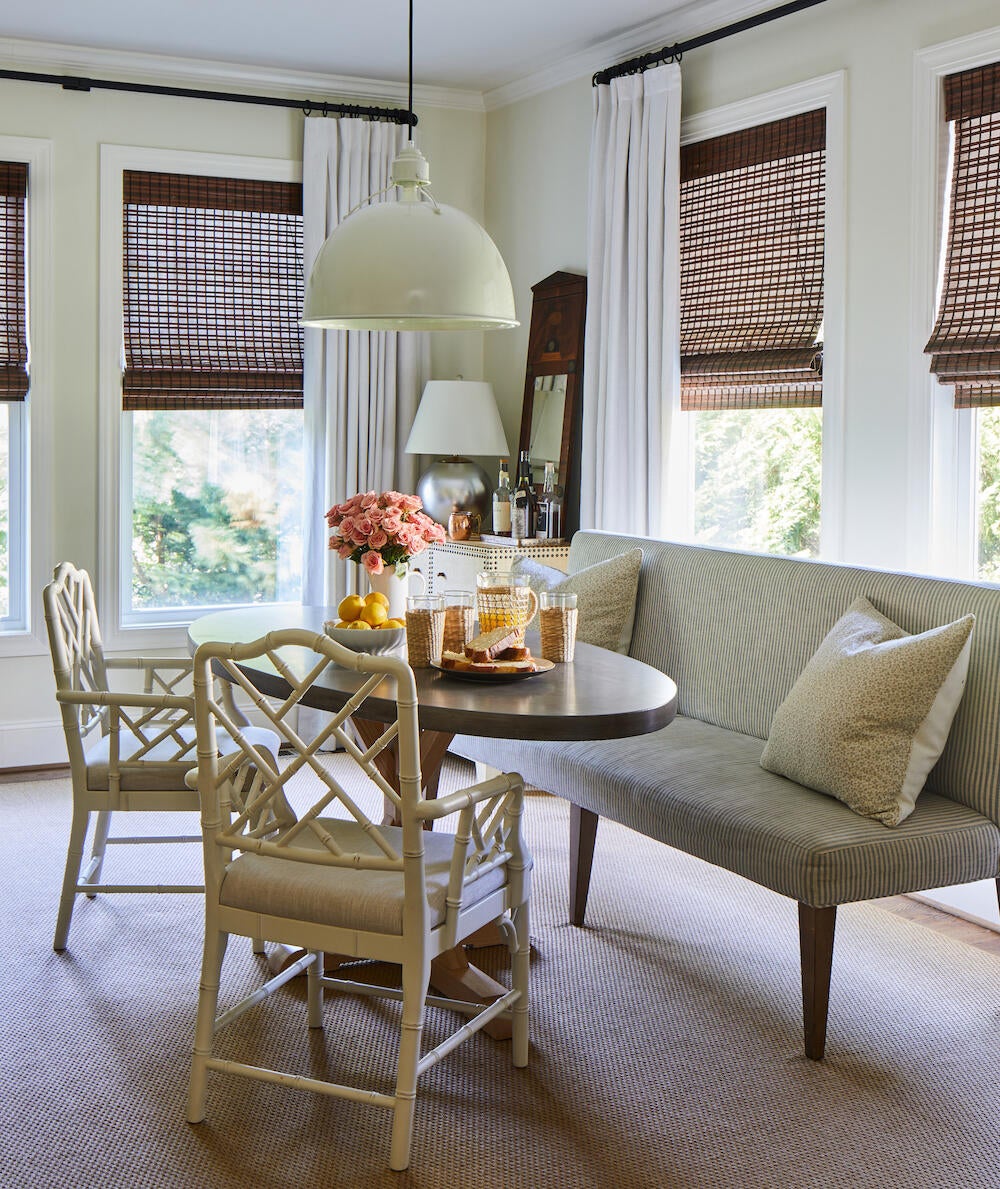
How has your pricing structure changed as your business has grown?
I just changed my rate to $200 an hour, and my markup is sort of variable depending on the vendor and the price I get from them. I certainly try to be competitive [with my pricing] if it’s something that’s easily shoppable—you can get Schumacher fabric on Wayfair now—so it might be [as low as] 15 percent. But then if I find something for $40 at a junk store, I might charge $100 for it.
How do you explain that to clients?
I just tell people when we talk about it, it’s the minimum 15 percent uplift. And if you find something on your own, great, I’m not going to charge you a percentage. I don’t care where we get stuff, I just care that the end result is as good as it can be. That’s usually my spiel. I find that most of my clients are OK paying me, and they see a lot of value in my time, but I think a lot of people want a bargain on the furnishings. So I am committed to billing for every single minute that I’m working on their project, and I’m very disciplined about clocking in and clocking out. I’m keeping track if we texted for 20 minutes, and then I’ll add that to [their bill under] incidental communication. I feel like it allows me to be more flexible when it comes to [revenue from product]. Like my Nantucket project—I made plenty of money on lighting and wallcoverings and fabric, but obviously there was a lot of income potential there that I did not get because we shopped Facebook Marketplace.
Right, the margin on that is going to be much smaller.
But I like gathering things and collecting and curating. I think the project can be better for it, and I think people trust you more. I’m also not going to be the one coordinating pickup and delivery and inspecting it. When a client sends you a photo of something on Facebook Marketplace or 1stDibs or Chairish and says, “What do you think of this?” I know a lot of designers who will send them a bill for 15 percent of the total, but that’s just not something I feel good about at this time. That probably doesn’t make me a very good businessperson—and I have designer friends all the time telling me, “No, you have to charge for that”—but that part I really struggle with.
Has handing billing off to your assistant made that any easier?
It has helped tremendously, and I highly recommend that approach. Really, I’m an artist. In the end, I just want the room to look good. I don’t care that making money is secondary to that. So I’m not going to win any business awards. But I do think the more I can move away from the business side of things, the better.
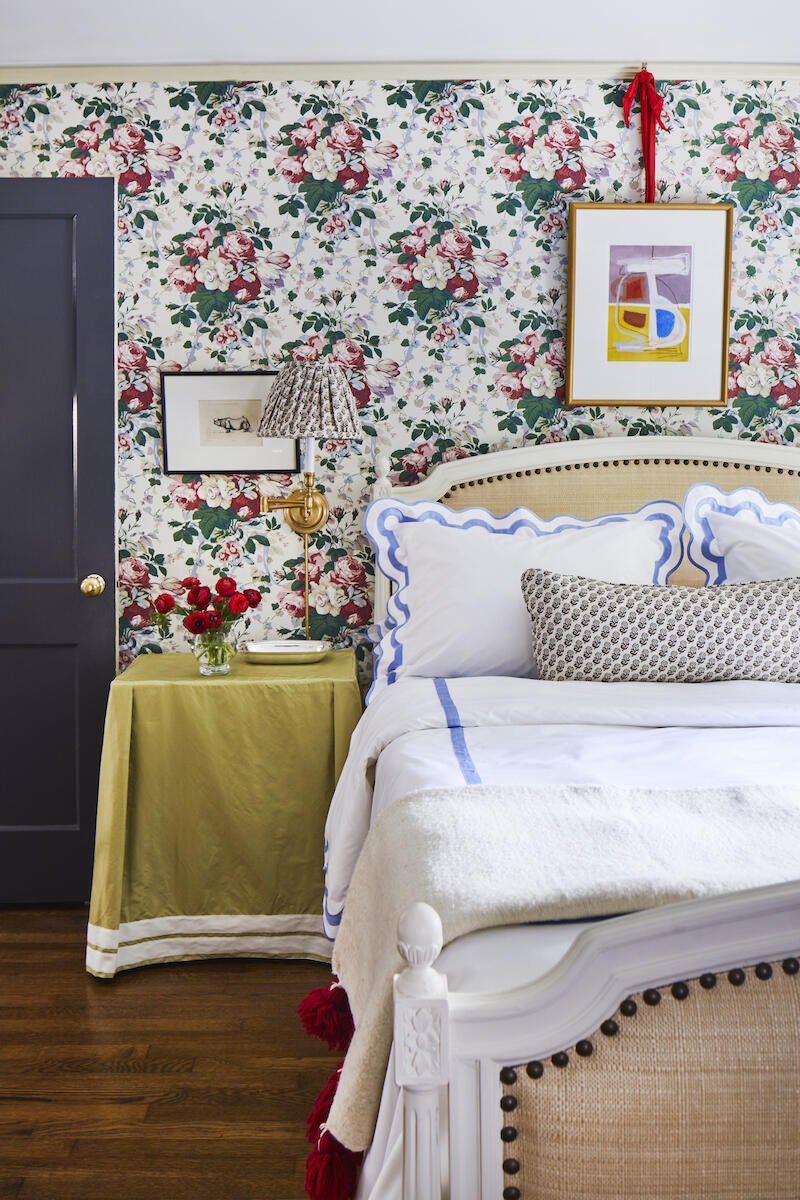
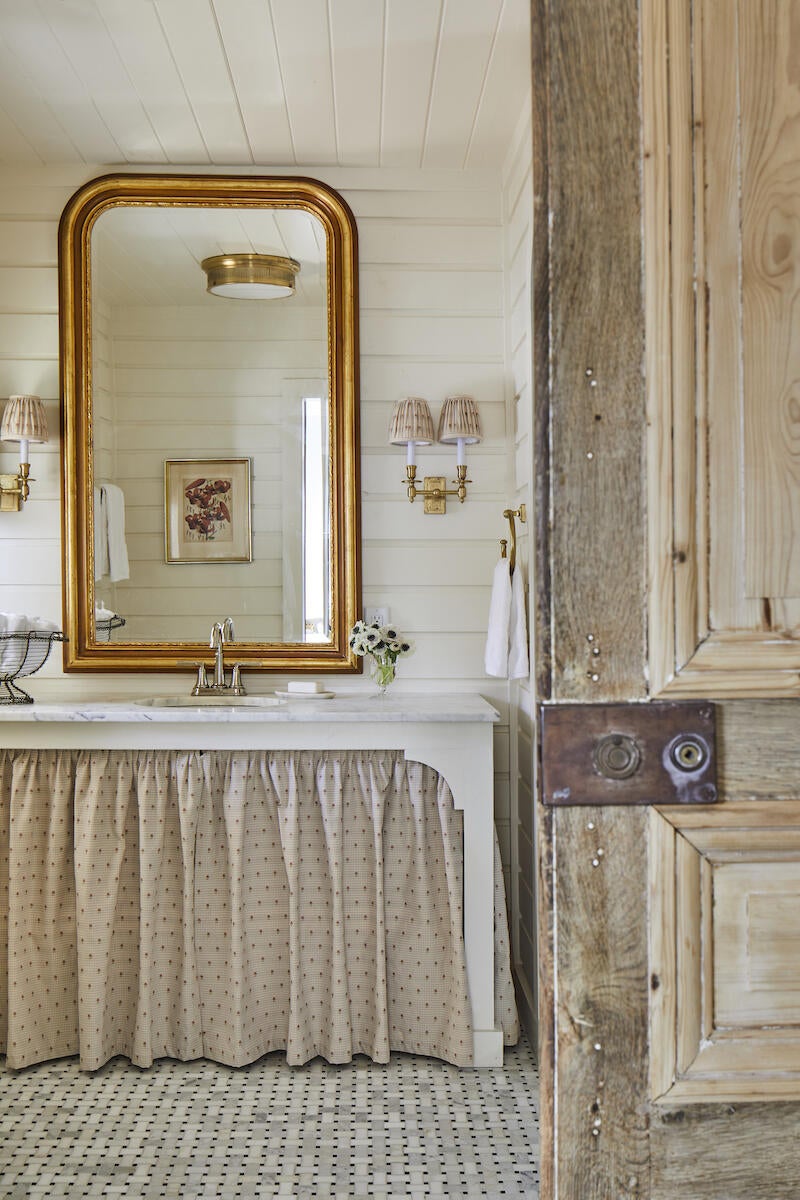
When you look back, what is the biggest thing you know now that you wish you had known when you started your firm?
No matter how much urgency you feel to get to a hypothetical end of a project, you can’t rush it. Everything builds on each preceding step. Even now, I have to remind myself, “I feel this urgency, and I just want this bigger project, but I can’t rush it.” There are things that maybe I still have to learn. You can’t get to the next step until you finish building the steps that you’re on.
Also, I’m probably not going to be satisfied. It’s just my nature. It’s not going to be like, “Once you get that $10 million project, you’re going to feel like you made it.” When I get the $10 million project, I’m probably going to be like, “But I want to do a hotel.” And I just have to be OK with that.
It’s the journey.
Exactly. It’s not a means to an end. Just enjoy it.
I love that. You operate a rental property, right? What’s the story with that?
My dad had been wanting a house in the mountains. He always had the renovation bug. He has watched me work from afar, and he kept saying, “Let’s do some flips. Let’s do some flips.” He was really pushing, so I took him to Highlands, North Carolina. He’d never heard of it, but he loved it. I think I took him up there in July of 2019. It was 95 degrees when we left Greenville, and [when] we got to Highlands, it was 75 degrees.
Everyone says it’s perfect.
Yeah, it’s beautiful, the mountains and the views. And so I started getting Zillow alerts. In January of 2020, I got an alert for a dilapidated red home with white trim—and I swear, if I hadn’t just been at the Brentwood Country Mart, I probably would have not even taken a second look. But it was the same color with the white trim, and I was like, “Oh, my God.” The listing also said it was 250 square feet, and I was like, “This can’t be right,” so I reached out to a realtor. I went and saw it on a Monday, and on Wednesday we made an offer.
What was it about the house that you knew when you saw it?
I’m a millwork fiend, and there was woodwork everywhere. A lot of it was wormy chestnut, which is super-duper rare—it doesn’t grow to lumber length anymore because there was a blight. And the location was great, in a sweet little gated community, but there are no country club dues. That is something you run into a lot up there—you can buy a house, but then you have to pay $80,000 for membership to a club.
I’m just a sucker for an old house. I could see the potential. The floor plan was good. It’s on an acre of pretty land. There are some houses I walk into where I’m like, “I can’t help you.” But with this house, I could see it all right away.
Then my dad came up to see it, and I think he almost had a heart attack because it was in such bad shape. But I just knew—I mean, I doubt myself a lot, so when I feel sure about something, I know I can trust that. This was just one of those things where I just had no doubt in my mind. And that house ended up being my second Southern Living feature.
Did you end up flipping it, or renting it out?
We have it on Airbnb, but it’s mostly our vacation home. It does rent, but we also use it a lot. And I actually got more traction after that publication—that was in Southern Living in September of 2021, and it’s been a rainmaker.My Nantucket clients found me because they saw that Julia Berolzheimer had stayed at the house, and they found the house that way. So then during the pandemic, they came and rented the house, even though it was not fully finished yet. But then when they decided to buy their house in Nantucket, they called me for their house in Nantucket. My client in D.C. came from that project too.
Did it feel different to you in any way aesthetically that would make its impact so much greater?
It was more subdued. And I had obviously evolved a little bit stylistically since doing the first house. It was gratifying to try a different thing and get such good feedback.
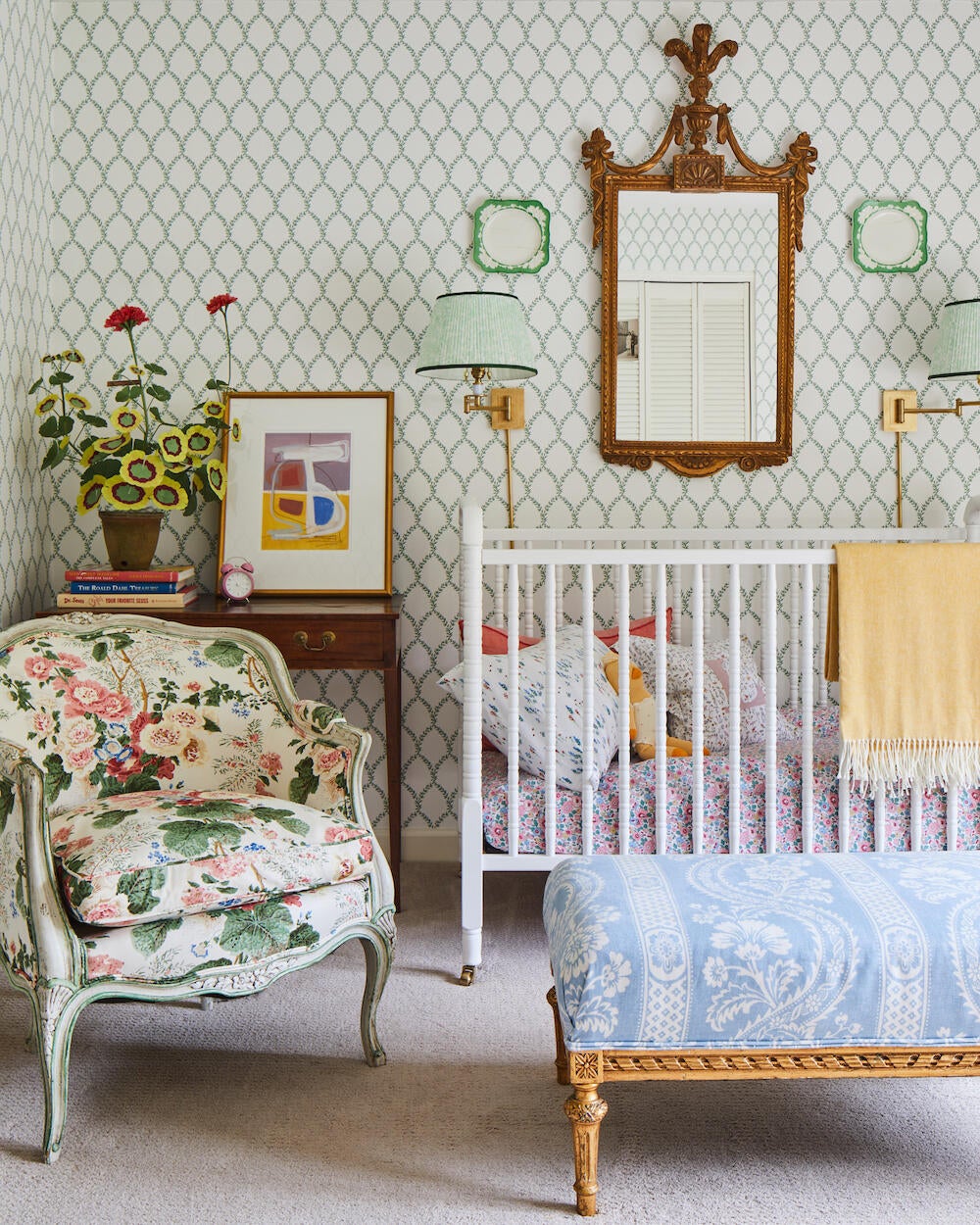
What does success look like to you?
“Respect” is the first word that comes to mind—far more than “money.”
I love that. Respect in what way?
I think the respect of my peers, which I also think is so stupid—like, who cares? Success to me is being regarded as somebody who was great at design. For example, I know that Bunny Williams is very financially successful, but what I aspire to most is to be considered a “great” the way she is. That’s success to me.
I love that you know that about yourself too. I think so many people can’t articulate that as clearly.
I mean, money’s good too.
We’ve talked a little bit about Greenville, but can you tell me about the housing market and the local projects?
I love Greenville as a place to live, and we love South Carolina. I came down here for college and never left—I’m totally enamored with the Southern mystique. There’s something that you can’t put your finger on about the South that I love. It’s beautiful here, and I probably won’t ever leave. There are a lot of people moving here too—we saw it during the pandemic, and it’s growing quickly, so it will be interesting to see how Greenville’s identity changes and evolves as these other influences come in.
I have a lot of pride in where we live, but as a business owner, I haven’t really found my people here. That’s why I work out of state a lot.
Aesthetically, what are your clients leaning toward right now?
More than ever, I think people are wanting nostalgia. We’ve had such a freakin’ scary two years, and it’s not looking like it’s going to let up. And people are just like, “I want to feel like I’m just tugging on my favorite sweater. I want to feel comfort, and I want to feel reminded of happier times and good memories.” I have a lot of clients moving toward natural materials, and I’m seeing a lot of brown furniture. It’s funny, because when I work with a baby boomer, they’ll say, “Oh, no, I don’t want to do that. That reminds me of my grandmother’s house” —like it’s a bad thing. But when I hear it from millennials, it’s a good thing. They want that because it reminds them of their grandmother.
To learn more about Whitney McGregor, visit her website or find her on Instagram.
















